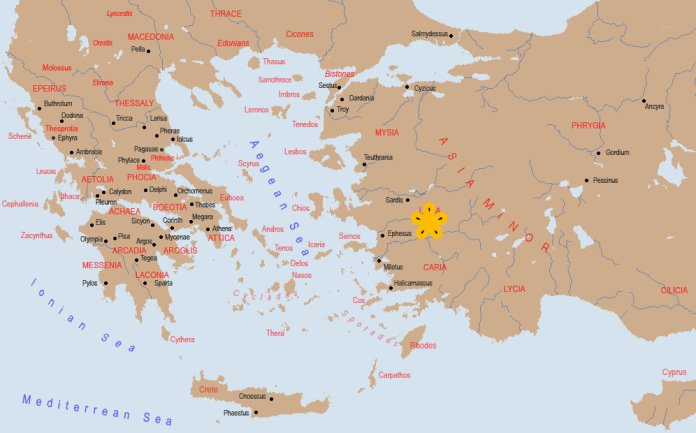Ephesus was an Ancient Greek city located on the west coast of Asia Minor, modern-day Turkey. Its history stretches back to 1,000 BC.
Being one of the largest cities in antiquity, it was the center of travel and commerce. Stretched on the Aegean Sea the city of Ephesus was one of the greatest seaports of the ancient world and it was famed for its cult for the Goddess Artemis in a Temple whose magnificence permit it to be classified among the seven wonders of the ancient world.
_____________________________________________
http://www.susannagalanis.com Online store
_____________________________________________
Thanks to the Temple of Artemis the bustling port of the city grew large and wealthy. Beautiful stone buildings lined its streets and a huge amphitheater/stadium for gladiatorial games kept the populus entertained. At its height, some 250 thousand lived in Ephesus making it one of the largest cities of the ancient world.
Following his conquest of the Greek city of Ephesus and several other Greek cities on the Asian coast, King Croesus [King of Lydia, an ancient kingdom in Asia Minor] build the temple to honor its Goddess Artemis. Completed around 550 BC, the temple was designed by the Greek architect, Chersiphron and it was revolutionary in design – was said to have rivaled the Parthenon in size and fame. This ancient wonder made of marble with a cedar roof, and ornamented inside and outside with gold, was overflowing with treasures.
 Image (suggestion) of The Temple of Artemis at Ephesus
Image (suggestion) of The Temple of Artemis at Ephesus
The temple of Artemis had 127 columns (each around 66 feet tall) with the front rows decorated with intricate sculpture. A statue of the Goddess Artemis — an Anatolian Mother Goddess, with its enormous power and influence associated with, stood in the middle.
 Image Map of Asia Minor (Modern-day Turkey)
Image Map of Asia Minor (Modern-day Turkey)
Artemis was the Hellenic goddess of the hunt, wild animals, wilderness, childbirth, virginity, and young girls and twin of Apollo. At Ephesus, a goddess whom the Greeks associated with Artemis was passionately venerated in an archaic icon. She was worshiped primarily as the “Mother Goddess. This was the Artemis of Ephesus.
Image of Greek Goddess Artemis-Left
Image of Ephesian Goddess Artemis – Left
Artemis of Ephesus was carved of wood, with many breast-like protuberances apparently emphasizing fertility over the virginity traditionally associated with the Greek Artemis. The statute of the many-breasted Artemis was the symbol of the temple as well the symbol of abundance, hunting and wild life. The temple became an important attraction visited by merchants, kings,and sightseers, many of whom paid homage to the goddess in form of jewelry and various other treasures. It also offered sanctuary to those fleeing persecution or punishment, a tradition linked to the myth of the Amazons who twice fled these seeking the goddesses’ protection from punishment firstly by Dionysus and later by Heracles (more about the Amazons on a later post).
The wealth and splendour of the temple and the city of Ephesus were taken as evidence of Artemis Ephesian’s power, and were the basis of her local and international prestige – a gift and honor to the goddess brought prosperity. The splendor and beauty of the temple at the time is described by a visitor, Antipater of Sidon who commented: …But when I saw the sacred house of Artemis that towers to the clouds, the [other of the seven wonders of the ancient world] were places in the shade, for the Sun himself has never looked upon its equal outside Olympus.
On the night of July 21, 356 BC a man named Herostratus set fire to the temple in an attempt to immortalize his name. According to historian Plutarch, the burning of the temple coincided with the birth of Alexander – Artemis was too preoccupied with Alexander’s delivery to save her temple from its fiery destruction. This destruction was considered a very bad omen by the Persian magi who interpreted this as the destruction of the Persian empire. 
Alexander the Grea – King of Macedonia statue
When Alexander the Great defeated the Persian forces [who at that point had conquered the Lydians], in the battle of Granicus in 334 BC, the Greek cities of Asia Minor were liberated – Alexander was greeted warmly when he entered Ephesus in triumph. Legend has it that Alexander offered to rebuild the destroyed temple, after all the Goddess Artemis was overseeing the safe delivery of his birth and was not able to save her temple. He was told however, that it was not fit for a God such as himself [as he was considered by many] to build a temple honoring another God. Alexander gave the city of Ephesus special privileges. A different version of the story is, that the Temple was restored with the help of Alexander.
In 262 AD the temple was destroyed again, it was restored but this great monument eventually began to lose its importance as many began switching to Christianity and the town of Ephesus was eventually deserted. In recent years, archeologists have discovered and excavated the town. The British Museum in London counts some of the temples sculptures among its treasures.
…more about Alexander the Great and the cult of Artemis of Ephesus [which I find incredibly fascinating] coming up soon…


